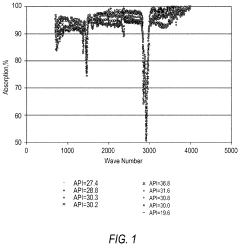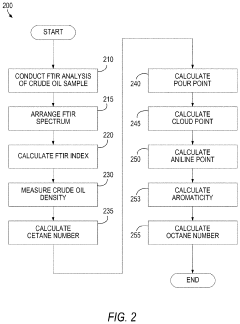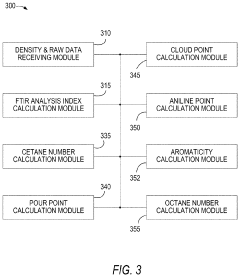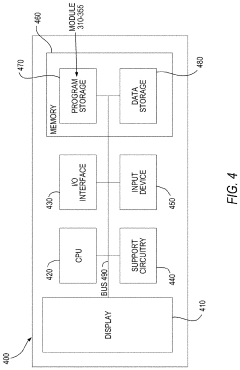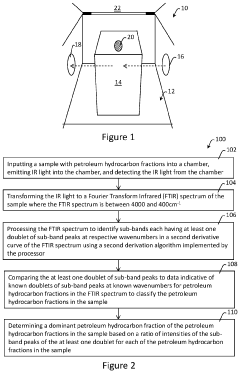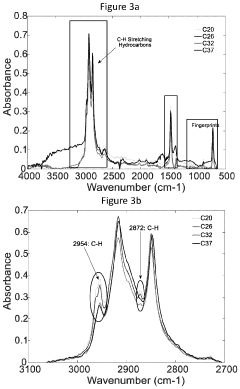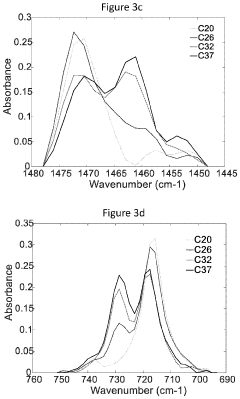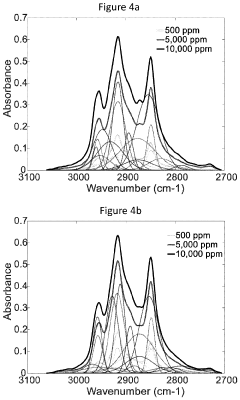Future of FTIR in Tracking Environmental Pollutants
SEP 22, 20259 MIN READ
Generate Your Research Report Instantly with AI Agent
Patsnap Eureka helps you evaluate technical feasibility & market potential.
FTIR Technology Evolution and Environmental Monitoring Goals
Fourier Transform Infrared Spectroscopy (FTIR) has evolved significantly since its inception in the mid-20th century, transforming from a laboratory curiosity to an essential analytical tool for environmental monitoring. The technology's development trajectory has been characterized by continuous improvements in sensitivity, resolution, and portability, enabling increasingly sophisticated applications in pollution detection and analysis.
The evolution of FTIR technology can be traced through several key phases. Initially, FTIR systems were large, expensive instruments confined to specialized laboratories. The 1980s saw the introduction of more compact designs with improved computing capabilities, while the 1990s brought significant advances in detector technology and sampling techniques. The early 2000s marked a turning point with the emergence of portable and field-deployable FTIR systems, fundamentally changing how environmental monitoring could be conducted.
Recent technological advancements have focused on enhancing spectral resolution, reducing interference, and developing more sophisticated data processing algorithms. Modern FTIR systems incorporate advanced optics, high-sensitivity detectors, and powerful computational capabilities that enable real-time analysis of complex environmental samples. These improvements have dramatically expanded the range of pollutants that can be detected and quantified using FTIR technology.
The primary goal of FTIR application in environmental monitoring is to provide accurate, real-time detection and quantification of pollutants across various environmental matrices. This includes atmospheric monitoring of greenhouse gases and air pollutants, analysis of contaminants in water bodies, and assessment of soil contamination. The technology aims to support both regulatory compliance efforts and scientific research into pollution dynamics and environmental impacts.
A significant trend in FTIR development is the integration with other analytical techniques and monitoring systems. Hybrid approaches combining FTIR with mass spectrometry, gas chromatography, or remote sensing technologies are emerging as powerful tools for comprehensive environmental assessment. These integrated systems offer enhanced capabilities for identifying and tracking complex mixtures of pollutants in diverse environmental settings.
Looking forward, the evolution of FTIR technology is expected to continue along several trajectories. Miniaturization and cost reduction will likely make the technology more accessible for widespread deployment in environmental monitoring networks. Advances in artificial intelligence and machine learning promise to enhance data interpretation capabilities, enabling more sophisticated pattern recognition and predictive analytics for pollution trends.
The ultimate technical goal is to develop FTIR systems that can provide continuous, autonomous monitoring of multiple pollutants across different environmental media with minimal maintenance requirements. Such systems would revolutionize our ability to track pollution sources, understand transport mechanisms, and implement effective mitigation strategies.
The evolution of FTIR technology can be traced through several key phases. Initially, FTIR systems were large, expensive instruments confined to specialized laboratories. The 1980s saw the introduction of more compact designs with improved computing capabilities, while the 1990s brought significant advances in detector technology and sampling techniques. The early 2000s marked a turning point with the emergence of portable and field-deployable FTIR systems, fundamentally changing how environmental monitoring could be conducted.
Recent technological advancements have focused on enhancing spectral resolution, reducing interference, and developing more sophisticated data processing algorithms. Modern FTIR systems incorporate advanced optics, high-sensitivity detectors, and powerful computational capabilities that enable real-time analysis of complex environmental samples. These improvements have dramatically expanded the range of pollutants that can be detected and quantified using FTIR technology.
The primary goal of FTIR application in environmental monitoring is to provide accurate, real-time detection and quantification of pollutants across various environmental matrices. This includes atmospheric monitoring of greenhouse gases and air pollutants, analysis of contaminants in water bodies, and assessment of soil contamination. The technology aims to support both regulatory compliance efforts and scientific research into pollution dynamics and environmental impacts.
A significant trend in FTIR development is the integration with other analytical techniques and monitoring systems. Hybrid approaches combining FTIR with mass spectrometry, gas chromatography, or remote sensing technologies are emerging as powerful tools for comprehensive environmental assessment. These integrated systems offer enhanced capabilities for identifying and tracking complex mixtures of pollutants in diverse environmental settings.
Looking forward, the evolution of FTIR technology is expected to continue along several trajectories. Miniaturization and cost reduction will likely make the technology more accessible for widespread deployment in environmental monitoring networks. Advances in artificial intelligence and machine learning promise to enhance data interpretation capabilities, enabling more sophisticated pattern recognition and predictive analytics for pollution trends.
The ultimate technical goal is to develop FTIR systems that can provide continuous, autonomous monitoring of multiple pollutants across different environmental media with minimal maintenance requirements. Such systems would revolutionize our ability to track pollution sources, understand transport mechanisms, and implement effective mitigation strategies.
Market Demand for Advanced Pollutant Detection Systems
The global market for advanced pollutant detection systems is experiencing significant growth, driven by increasing environmental concerns and stricter regulatory frameworks worldwide. The demand for Fourier Transform Infrared (FTIR) spectroscopy in environmental monitoring has seen a compound annual growth rate of approximately 6.8% between 2018 and 2023, with projections indicating continued expansion through 2030.
Industrial sectors, particularly chemical manufacturing, oil and gas, and pharmaceuticals, represent the largest market segment for FTIR-based pollutant detection systems. These industries face mounting pressure from regulatory bodies to monitor and reduce emissions of volatile organic compounds (VOCs), greenhouse gases, and other harmful pollutants. The implementation of more stringent environmental protection policies in major economies has created a substantial market pull for real-time, accurate monitoring solutions.
Municipal governments and environmental protection agencies constitute another significant market segment, with growing investments in air and water quality monitoring networks. The need for comprehensive urban pollution tracking systems has intensified as public awareness of environmental health impacts increases. This has translated into higher budget allocations for environmental monitoring infrastructure in both developed and developing regions.
The healthcare sector represents an emerging market for advanced pollutant detection, as research continues to establish stronger links between environmental pollutants and public health outcomes. Medical facilities and research institutions are increasingly incorporating environmental monitoring into their operations and studies, creating new application avenues for FTIR technology.
Consumer demand for personal environmental monitoring devices is also rising, particularly in regions with severe air pollution challenges such as parts of Asia and urban centers globally. This trend is creating opportunities for miniaturized, cost-effective FTIR solutions that can be integrated into portable or wearable devices.
Market research indicates that end-users are increasingly prioritizing detection systems with multi-pollutant capabilities, lower maintenance requirements, and seamless data integration features. The ability to detect multiple contaminants simultaneously while providing real-time data through cloud-based platforms represents a key value proposition for next-generation FTIR systems.
Geographic analysis reveals that North America and Europe currently lead in adoption of advanced FTIR-based environmental monitoring systems, primarily due to established regulatory frameworks. However, the Asia-Pacific region is expected to witness the fastest growth rate in the coming decade, driven by rapid industrialization, urbanization, and increasingly stringent environmental regulations in countries like China and India.
Industrial sectors, particularly chemical manufacturing, oil and gas, and pharmaceuticals, represent the largest market segment for FTIR-based pollutant detection systems. These industries face mounting pressure from regulatory bodies to monitor and reduce emissions of volatile organic compounds (VOCs), greenhouse gases, and other harmful pollutants. The implementation of more stringent environmental protection policies in major economies has created a substantial market pull for real-time, accurate monitoring solutions.
Municipal governments and environmental protection agencies constitute another significant market segment, with growing investments in air and water quality monitoring networks. The need for comprehensive urban pollution tracking systems has intensified as public awareness of environmental health impacts increases. This has translated into higher budget allocations for environmental monitoring infrastructure in both developed and developing regions.
The healthcare sector represents an emerging market for advanced pollutant detection, as research continues to establish stronger links between environmental pollutants and public health outcomes. Medical facilities and research institutions are increasingly incorporating environmental monitoring into their operations and studies, creating new application avenues for FTIR technology.
Consumer demand for personal environmental monitoring devices is also rising, particularly in regions with severe air pollution challenges such as parts of Asia and urban centers globally. This trend is creating opportunities for miniaturized, cost-effective FTIR solutions that can be integrated into portable or wearable devices.
Market research indicates that end-users are increasingly prioritizing detection systems with multi-pollutant capabilities, lower maintenance requirements, and seamless data integration features. The ability to detect multiple contaminants simultaneously while providing real-time data through cloud-based platforms represents a key value proposition for next-generation FTIR systems.
Geographic analysis reveals that North America and Europe currently lead in adoption of advanced FTIR-based environmental monitoring systems, primarily due to established regulatory frameworks. However, the Asia-Pacific region is expected to witness the fastest growth rate in the coming decade, driven by rapid industrialization, urbanization, and increasingly stringent environmental regulations in countries like China and India.
Current FTIR Applications and Technical Limitations
Fourier Transform Infrared (FTIR) spectroscopy has emerged as a powerful analytical technique for environmental pollutant monitoring, offering rapid, non-destructive analysis with minimal sample preparation. Currently, FTIR applications in environmental monitoring span multiple domains including air quality assessment, water contamination detection, soil pollution analysis, and industrial emission control.
In air quality monitoring, FTIR systems are deployed for continuous measurement of atmospheric pollutants including greenhouse gases, volatile organic compounds (VOCs), and particulate matter. Open-path FTIR systems can monitor pollutant concentrations across distances of several hundred meters, providing spatial distribution data that point sensors cannot deliver. Extractive FTIR systems are utilized for stack emission monitoring in industrial facilities, offering real-time data on multiple gas species simultaneously.
For water pollution tracking, FTIR spectroscopy enables detection of organic contaminants, microplastics, and petroleum hydrocarbons. The technique has proven particularly valuable for identifying emerging contaminants of concern such as pharmaceutical residues and personal care product chemicals that traditional water quality parameters might miss.
Despite these extensive applications, FTIR technology faces several significant technical limitations. Sensitivity constraints remain a primary challenge, with detection limits typically in the parts per million (ppm) range for many compounds, whereas environmental regulations increasingly demand parts per billion (ppb) detection capabilities. This sensitivity gap limits FTIR's application in ultra-trace analysis scenarios.
Spectral interference presents another substantial challenge. Environmental samples contain complex mixtures of compounds with overlapping spectral features, making accurate identification and quantification difficult. Current chemometric algorithms struggle with highly complex environmental matrices, particularly when unknown compounds are present.
Field deployability issues also restrict FTIR's broader adoption. Traditional FTIR instruments require controlled environments, stable power supplies, and regular maintenance. While portable FTIR systems exist, they typically sacrifice sensitivity and spectral resolution for mobility, limiting their practical utility in remote environmental monitoring applications.
Data interpretation complexity remains a significant barrier. Converting spectral data into actionable environmental intelligence requires sophisticated algorithms and reference libraries. Current commercial systems often lack comprehensive environmental pollutant spectral databases, necessitating custom calibration for specific applications.
Calibration drift and instrument stability in varying environmental conditions further complicate long-term monitoring applications. Temperature fluctuations, humidity changes, and mechanical vibrations can all affect measurement accuracy, requiring frequent recalibration that interrupts continuous monitoring efforts.
Cost considerations also limit widespread adoption, with high-resolution FTIR systems typically requiring substantial capital investment and specialized technical expertise for operation and maintenance, placing them beyond the reach of many environmental monitoring programs, particularly in developing regions.
In air quality monitoring, FTIR systems are deployed for continuous measurement of atmospheric pollutants including greenhouse gases, volatile organic compounds (VOCs), and particulate matter. Open-path FTIR systems can monitor pollutant concentrations across distances of several hundred meters, providing spatial distribution data that point sensors cannot deliver. Extractive FTIR systems are utilized for stack emission monitoring in industrial facilities, offering real-time data on multiple gas species simultaneously.
For water pollution tracking, FTIR spectroscopy enables detection of organic contaminants, microplastics, and petroleum hydrocarbons. The technique has proven particularly valuable for identifying emerging contaminants of concern such as pharmaceutical residues and personal care product chemicals that traditional water quality parameters might miss.
Despite these extensive applications, FTIR technology faces several significant technical limitations. Sensitivity constraints remain a primary challenge, with detection limits typically in the parts per million (ppm) range for many compounds, whereas environmental regulations increasingly demand parts per billion (ppb) detection capabilities. This sensitivity gap limits FTIR's application in ultra-trace analysis scenarios.
Spectral interference presents another substantial challenge. Environmental samples contain complex mixtures of compounds with overlapping spectral features, making accurate identification and quantification difficult. Current chemometric algorithms struggle with highly complex environmental matrices, particularly when unknown compounds are present.
Field deployability issues also restrict FTIR's broader adoption. Traditional FTIR instruments require controlled environments, stable power supplies, and regular maintenance. While portable FTIR systems exist, they typically sacrifice sensitivity and spectral resolution for mobility, limiting their practical utility in remote environmental monitoring applications.
Data interpretation complexity remains a significant barrier. Converting spectral data into actionable environmental intelligence requires sophisticated algorithms and reference libraries. Current commercial systems often lack comprehensive environmental pollutant spectral databases, necessitating custom calibration for specific applications.
Calibration drift and instrument stability in varying environmental conditions further complicate long-term monitoring applications. Temperature fluctuations, humidity changes, and mechanical vibrations can all affect measurement accuracy, requiring frequent recalibration that interrupts continuous monitoring efforts.
Cost considerations also limit widespread adoption, with high-resolution FTIR systems typically requiring substantial capital investment and specialized technical expertise for operation and maintenance, placing them beyond the reach of many environmental monitoring programs, particularly in developing regions.
Existing FTIR Solutions for Pollutant Tracking
01 FTIR spectroscopy instrumentation and design
Various designs and configurations of FTIR spectroscopy instruments are described, including portable devices, miniaturized systems, and specialized hardware components. These innovations focus on improving the optical path, detector sensitivity, and overall instrument performance. Some designs incorporate novel interferometer arrangements, specialized sample holders, or integrated components to enhance measurement accuracy and reliability in different applications.- FTIR spectroscopy instrumentation and design: Various designs and configurations of FTIR spectroscopy instruments are described, including portable devices, miniaturized systems, and specialized hardware components. These innovations focus on improving the optical path, detector sensitivity, and overall instrument performance. Some designs incorporate novel interferometer arrangements, beam splitters, or sample handling mechanisms to enhance measurement accuracy and reliability in different applications.
- Sample analysis and characterization techniques using FTIR: FTIR spectroscopy is applied for analyzing and characterizing various materials and substances. These techniques involve specific sample preparation methods, measurement protocols, and data interpretation approaches. FTIR enables identification of chemical compositions, molecular structures, and functional groups in samples ranging from organic compounds to complex mixtures. The spectral data obtained provides valuable information about material properties and chemical interactions.
- Integration of FTIR with other analytical methods: FTIR spectroscopy is combined with complementary analytical techniques to provide comprehensive material characterization. These integrated systems may combine FTIR with chromatography, mass spectrometry, thermal analysis, or microscopy. The synergistic approach allows for more detailed analysis of complex samples by correlating spectral information with other physical or chemical properties, enhancing the overall analytical capabilities and expanding the range of applications.
- FTIR data processing and analysis algorithms: Advanced algorithms and computational methods are developed for processing and analyzing FTIR spectral data. These include techniques for baseline correction, spectral deconvolution, peak identification, and multivariate analysis. Machine learning and artificial intelligence approaches are increasingly applied to extract meaningful information from complex spectral datasets, enabling automated identification, classification, and quantification of sample components.
- Specialized FTIR applications in various fields: FTIR spectroscopy is adapted for specialized applications across diverse fields including pharmaceutical analysis, environmental monitoring, food safety, materials science, and biomedical diagnostics. These applications involve customized sampling accessories, specific measurement protocols, and tailored data interpretation methods. FTIR techniques are particularly valuable for non-destructive testing, quality control, and process monitoring in industrial settings, as well as for research in academic and clinical environments.
02 Sample analysis and characterization techniques using FTIR
FTIR spectroscopy is applied for analyzing and characterizing various materials and substances. These techniques involve specific sample preparation methods, measurement protocols, and data interpretation approaches. FTIR enables identification of chemical compositions, structural properties, and molecular interactions in samples ranging from pharmaceuticals to polymers, biological materials, and industrial products. The spectral data obtained provides valuable information about functional groups and chemical bonds present in the analyzed substances.Expand Specific Solutions03 Integration of FTIR with other analytical methods
FTIR spectroscopy is combined with complementary analytical techniques to enhance characterization capabilities. These integrated systems may combine FTIR with microscopy, chromatography, thermal analysis, or other spectroscopic methods. Such combinations provide multi-dimensional analytical data, allowing for more comprehensive material characterization and analysis. The synergistic approach enables researchers to correlate spectral information with other physical or chemical properties of the samples.Expand Specific Solutions04 Real-time monitoring and process control applications
FTIR spectroscopy is implemented in real-time monitoring systems for industrial processes, quality control, and environmental applications. These systems enable continuous analysis of chemical reactions, manufacturing processes, or environmental conditions. The spectroscopic data is processed and analyzed in real-time to provide immediate feedback for process control, allowing for rapid detection of deviations or anomalies. This approach enhances efficiency, product quality, and safety in various industrial settings.Expand Specific Solutions05 Advanced data processing and analysis methods for FTIR
Sophisticated algorithms and computational methods are developed for processing and interpreting FTIR spectral data. These include chemometric techniques, machine learning approaches, and specialized software solutions for spectral analysis. Advanced data processing methods help in extracting meaningful information from complex spectral patterns, enabling automated identification, quantification, and classification of samples. These computational approaches enhance the sensitivity, specificity, and reliability of FTIR-based analytical methods.Expand Specific Solutions
Leading FTIR Manufacturers and Research Institutions
The FTIR technology for tracking environmental pollutants is in a growth phase, with an expanding market driven by increasing environmental regulations and monitoring needs. The global market is projected to reach significant scale as industries adopt advanced pollution detection methods. Leading research institutions like Hefei Institutes of Physical Science, Aerospace Information Research Institute, and universities including Wuhan University are advancing fundamental research, while commercial players such as Thermo Electron Scientific Instruments, MKS, and Advantest are developing practical applications. Companies like NEO Monitors and Spectra Analysis Instruments are creating specialized environmental monitoring solutions. The technology is maturing rapidly with innovations in portable devices, real-time monitoring capabilities, and integration with IoT systems, positioning FTIR as a critical tool in environmental protection strategies.
Thermo Electron Scientific Instruments LLC
Technical Solution: Thermo Electron has developed advanced FTIR systems specifically designed for environmental pollutant monitoring with high sensitivity and specificity. Their technology incorporates portable FTIR spectrometers with enhanced detection limits down to parts per billion for volatile organic compounds and greenhouse gases. The company's systems feature automated sampling interfaces that allow for continuous monitoring of multiple pollutants simultaneously in real-time. Their FTIR solutions integrate cloud-based data management platforms that enable remote access to monitoring data and automated reporting for regulatory compliance. Thermo's systems employ advanced chemometric algorithms for improved spectral analysis and interference correction, significantly enhancing the accuracy of pollutant identification in complex environmental matrices.
Strengths: Industry-leading detection sensitivity; comprehensive software suite for data analysis; robust field-deployable systems with minimal maintenance requirements. Weaknesses: Higher initial investment compared to some alternatives; requires specialized training for optimal operation; some limitations in extremely humid environments.
Hefei Zhongke Infrared Precision Instrument Co., Ltd.
Technical Solution: Hefei Zhongke has developed specialized FTIR instrumentation focused on environmental monitoring applications in both industrial and ambient settings. Their technology features high-throughput optical systems with enhanced sensitivity for detecting atmospheric pollutants at trace levels. The company has pioneered miniaturized FTIR systems that maintain analytical performance while significantly reducing size and power requirements, making them suitable for distributed monitoring networks. Their instruments incorporate advanced digital signal processing algorithms that improve detection limits and reduce interference from water vapor and CO2. Hefei Zhongke's systems feature automated calibration routines and intelligent diagnostic capabilities that minimize maintenance requirements and ensure data reliability in long-term monitoring applications.
Strengths: Cost-effective solutions compared to Western competitors; specialized designs for Asian environmental challenges like extreme air pollution; strong integration with IoT platforms for networked monitoring. Weaknesses: Less established global support infrastructure; more limited third-party software compatibility; somewhat less sensitivity for certain specialized applications.
Key Innovations in FTIR Spectroscopy for Pollution Detection
Characterization of crude oil and its fractions by fourier transform infrared (FTIR) spectroscopy analysis
PatentActiveUS10942160B2
Innovation
- Employing Fourier Transform Infrared Spectroscopy (FTIR) analysis to directly assess the indicative properties of crude oil fractions without fractionation, using a system that calculates these properties based on density and FTIR measurements, enabling rapid evaluation of crude oil quality.
Method of determining petroleum hydrocarbon fractions in a sample
PatentActiveUS11913878B2
Innovation
- A method and apparatus utilizing a handheld FTIR device that processes infrared spectra by applying a second derivative algorithm to identify sub-bands, comparing these to known peaks, and determining dominant petroleum hydrocarbon fractions based on intensity ratios, allowing for rapid and automated classification of alkanes in soil samples.
Regulatory Framework for Environmental Monitoring Technologies
The regulatory landscape governing environmental monitoring technologies is rapidly evolving in response to growing concerns about pollution and its impacts on public health and ecosystems. FTIR (Fourier Transform Infrared) spectroscopy, as an emerging tool for tracking environmental pollutants, faces a complex web of regulations that vary significantly across jurisdictions and continue to develop as the technology advances.
At the international level, agreements such as the Paris Climate Accord and the Stockholm Convention on Persistent Organic Pollutants establish frameworks that increasingly demand precise monitoring capabilities. These agreements are driving the adoption of standardized monitoring protocols where FTIR technologies must demonstrate compliance with specific sensitivity, accuracy, and reliability benchmarks.
In the United States, the Environmental Protection Agency (EPA) has established the Environmental Technology Verification (ETV) Program, which evaluates the performance of innovative environmental technologies, including advanced spectroscopic methods like FTIR. The Clean Air Act and Clean Water Act further mandate specific monitoring requirements that influence the deployment and validation of FTIR systems for regulatory compliance.
The European Union's regulatory approach is guided by the REACH regulation (Registration, Evaluation, Authorization and Restriction of Chemicals) and the Industrial Emissions Directive, which establish stringent requirements for monitoring and reporting environmental pollutants. The EU has also developed the Best Available Techniques Reference Documents (BREFs) that increasingly recognize spectroscopic methods as preferred monitoring technologies.
Emerging economies, particularly China and India, are rapidly strengthening their environmental monitoring regulations. China's revised Environmental Protection Law and India's National Clean Air Programme are creating new markets for advanced monitoring technologies, though regulatory enforcement remains variable.
A significant trend in regulatory frameworks is the move toward continuous emissions monitoring systems (CEMS) that can provide real-time data. This shift favors technologies like FTIR that can simultaneously detect multiple pollutants with high temporal resolution. Regulatory bodies are increasingly requiring not just periodic sampling but continuous monitoring of critical pollutants, particularly in industrial settings and urban environments.
Data quality assurance and validation protocols represent another critical aspect of the regulatory framework. Standards organizations such as ISO, ASTM, and CEN have developed specific methodologies for validating spectroscopic measurements, which FTIR systems must satisfy to generate legally defensible data for compliance reporting.
At the international level, agreements such as the Paris Climate Accord and the Stockholm Convention on Persistent Organic Pollutants establish frameworks that increasingly demand precise monitoring capabilities. These agreements are driving the adoption of standardized monitoring protocols where FTIR technologies must demonstrate compliance with specific sensitivity, accuracy, and reliability benchmarks.
In the United States, the Environmental Protection Agency (EPA) has established the Environmental Technology Verification (ETV) Program, which evaluates the performance of innovative environmental technologies, including advanced spectroscopic methods like FTIR. The Clean Air Act and Clean Water Act further mandate specific monitoring requirements that influence the deployment and validation of FTIR systems for regulatory compliance.
The European Union's regulatory approach is guided by the REACH regulation (Registration, Evaluation, Authorization and Restriction of Chemicals) and the Industrial Emissions Directive, which establish stringent requirements for monitoring and reporting environmental pollutants. The EU has also developed the Best Available Techniques Reference Documents (BREFs) that increasingly recognize spectroscopic methods as preferred monitoring technologies.
Emerging economies, particularly China and India, are rapidly strengthening their environmental monitoring regulations. China's revised Environmental Protection Law and India's National Clean Air Programme are creating new markets for advanced monitoring technologies, though regulatory enforcement remains variable.
A significant trend in regulatory frameworks is the move toward continuous emissions monitoring systems (CEMS) that can provide real-time data. This shift favors technologies like FTIR that can simultaneously detect multiple pollutants with high temporal resolution. Regulatory bodies are increasingly requiring not just periodic sampling but continuous monitoring of critical pollutants, particularly in industrial settings and urban environments.
Data quality assurance and validation protocols represent another critical aspect of the regulatory framework. Standards organizations such as ISO, ASTM, and CEN have developed specific methodologies for validating spectroscopic measurements, which FTIR systems must satisfy to generate legally defensible data for compliance reporting.
Cost-Benefit Analysis of FTIR Implementation
The implementation of Fourier Transform Infrared (FTIR) spectroscopy for environmental pollutant tracking requires careful cost-benefit analysis to justify investment decisions. Initial capital expenditure for FTIR systems ranges from $50,000 to $250,000 depending on resolution, sensitivity, and portability requirements. High-end portable systems designed for field deployment command premium prices but offer significant operational advantages in remote monitoring scenarios.
Operational costs include maintenance contracts (typically 10-15% of initial equipment cost annually), specialized training for technicians ($2,000-5,000 per person), and consumables such as reference gases and calibration materials. Cloud-based data storage and analysis platforms add subscription costs ranging from $5,000-15,000 annually depending on data volume and processing requirements.
Against these costs, FTIR implementation delivers substantial quantifiable benefits. Laboratory testing costs reduction ranges from 30-50% compared to traditional methods when analyzing multiple pollutants simultaneously. The technology enables real-time detection capabilities that provide early warning of pollution events, potentially preventing environmental damage valued at hundreds of thousands to millions of dollars per incident.
Regulatory compliance benefits include reduced risk of non-compliance penalties, which can exceed $10,000 per day for serious violations in many jurisdictions. The comprehensive pollutant profiles generated by FTIR provide defensible documentation for regulatory reporting, reducing legal exposure and associated costs.
Long-term ROI analysis indicates most FTIR implementations achieve break-even within 2-4 years depending on deployment scale and application. Organizations conducting frequent multi-pollutant analyses typically realize faster returns than those with limited monitoring requirements.
Intangible benefits include enhanced corporate environmental stewardship reputation, which increasingly influences stakeholder relations and investment decisions. The ability to rapidly identify and address emerging pollutant concerns before they become regulatory requirements represents a strategic advantage difficult to quantify but potentially significant.
Risk factors affecting cost-benefit calculations include technology obsolescence, changing regulatory requirements, and the need for periodic system upgrades. Organizations should budget for 15-20% of initial system cost for upgrades every 3-5 years to maintain optimal performance and compatibility with evolving analytical methods.
Operational costs include maintenance contracts (typically 10-15% of initial equipment cost annually), specialized training for technicians ($2,000-5,000 per person), and consumables such as reference gases and calibration materials. Cloud-based data storage and analysis platforms add subscription costs ranging from $5,000-15,000 annually depending on data volume and processing requirements.
Against these costs, FTIR implementation delivers substantial quantifiable benefits. Laboratory testing costs reduction ranges from 30-50% compared to traditional methods when analyzing multiple pollutants simultaneously. The technology enables real-time detection capabilities that provide early warning of pollution events, potentially preventing environmental damage valued at hundreds of thousands to millions of dollars per incident.
Regulatory compliance benefits include reduced risk of non-compliance penalties, which can exceed $10,000 per day for serious violations in many jurisdictions. The comprehensive pollutant profiles generated by FTIR provide defensible documentation for regulatory reporting, reducing legal exposure and associated costs.
Long-term ROI analysis indicates most FTIR implementations achieve break-even within 2-4 years depending on deployment scale and application. Organizations conducting frequent multi-pollutant analyses typically realize faster returns than those with limited monitoring requirements.
Intangible benefits include enhanced corporate environmental stewardship reputation, which increasingly influences stakeholder relations and investment decisions. The ability to rapidly identify and address emerging pollutant concerns before they become regulatory requirements represents a strategic advantage difficult to quantify but potentially significant.
Risk factors affecting cost-benefit calculations include technology obsolescence, changing regulatory requirements, and the need for periodic system upgrades. Organizations should budget for 15-20% of initial system cost for upgrades every 3-5 years to maintain optimal performance and compatibility with evolving analytical methods.
Unlock deeper insights with Patsnap Eureka Quick Research — get a full tech report to explore trends and direct your research. Try now!
Generate Your Research Report Instantly with AI Agent
Supercharge your innovation with Patsnap Eureka AI Agent Platform!
